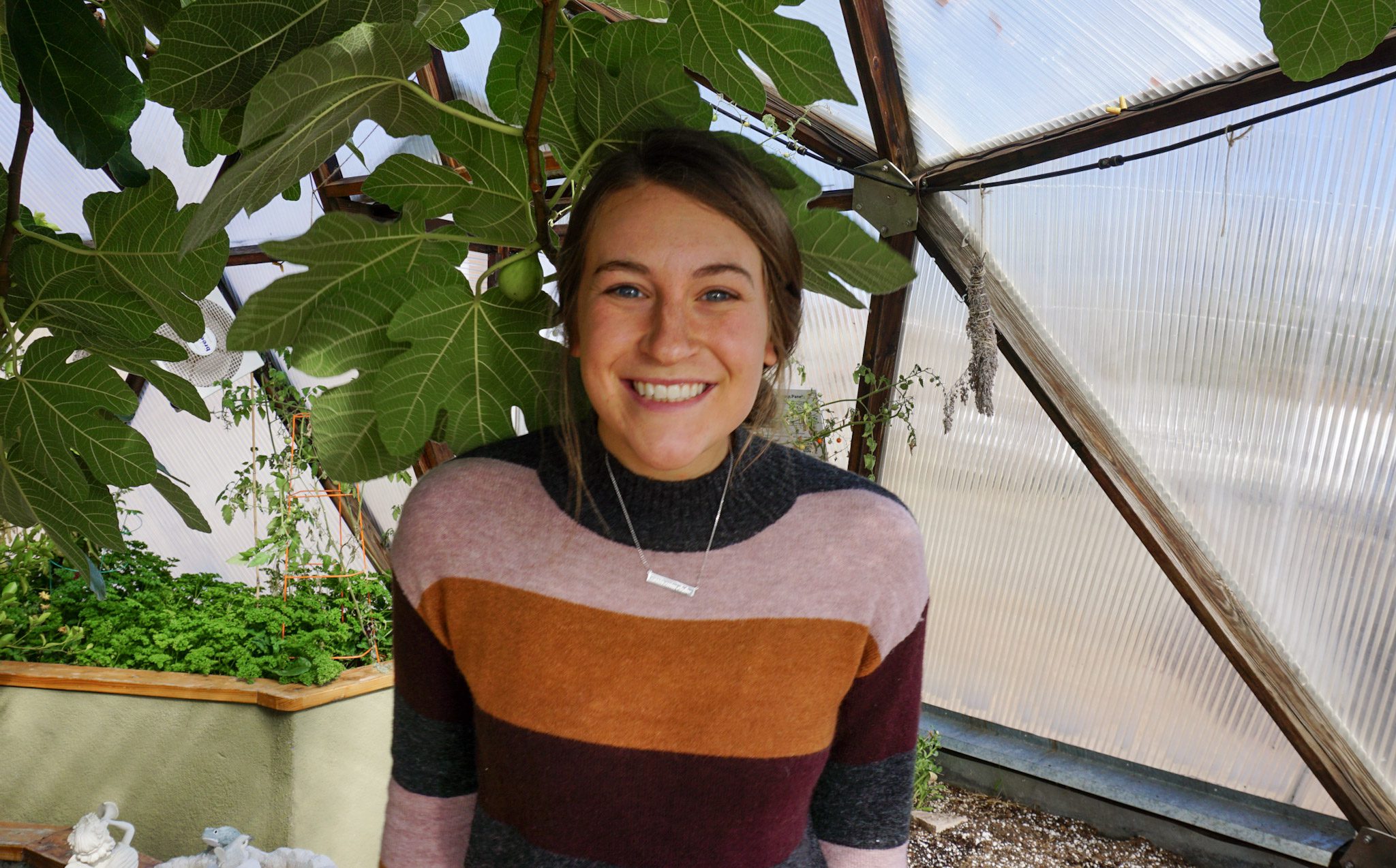
Planting in Your Climate Zone
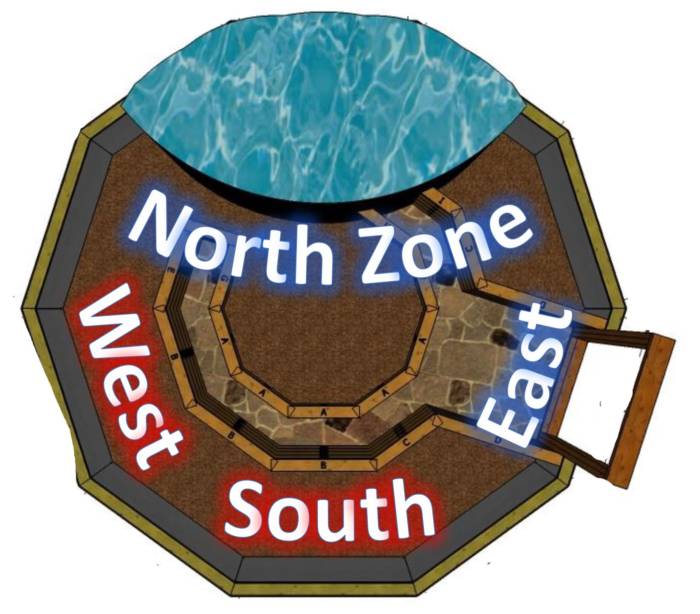
Every Growing Dome greenhouse has micro-climates. Each micro-climate provides optimal growing areas for different types of plants. Growing the right plants in the right location will help to ensure your gardening success. Thus we give you an in-depth greenhouse planting guide.
The zones vary depending on the size of your dome, USDA plant hardiness zone, your raised bed design, and your vent and fan locations. Generally speaking, the climate zones correspond with the North, East, South, and West sides of your dome.
North Zone/Water Tank:
The above-ground pond is fastened to the north side of your dome. The water in the pond maintains a relatively steady temperature and it evaporates, adding moisture to the air. Less light reaches the area near the pond in the summer if there are trees or tall, towering plants inside the dome. The soil and air temperatures by the pond typically remain more stable than the areas farther away from the pond. Also, soil nearest to the pond tends to retain moisture longer. This zone includes the northern half of the raised bed(s) in the center of the dome, or in larger domes, the raised beds closest to the pond.

For the North Zone, plant various greens and herbs that don’t grow well in direct sunlight or intense heat. Any plant that is prone to bolting (going to seed), such as arugula or cilantro, are excellent choices. Some root vegetables benefit from the dimmed light and steady temperatures too. The raised bed(s) in the center of the dome are optimal for planting trees (like dwarf fig) and shrubs of all kinds as it gives them plenty of space for their roots, and once again, stable soil and air temperatures.
East Zone:
The perimeter raised beds on the eastern side of the dome tend to be a little cooler than those on the south and west. This eastern area of the perimeter beds is best suited to grow leafy greens that require a little less light such collards, romaine lettuce, cabbages, basil, etc.
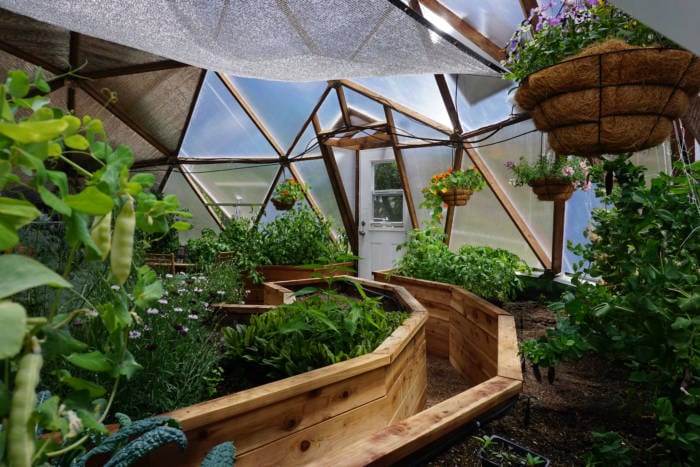
South Zone:
Perimeter beds on the south side of the dome get the most light, but they have the most unstable temperatures and tend to dry out faster.
Plants that are prone to fungal infections like tomatoes, potatoes, eggplants, peppers, cucumbers, melons, squashes, green beans, and peas should be planted in front of or near vents or fans on the east, west, or south. Particularly, the west and south locations are best suited to these plants.
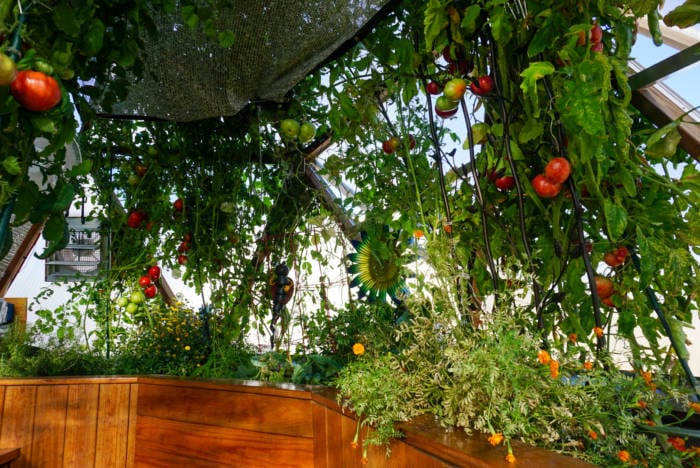
West Zone:
Perimeter raised beds on the western side of the dome receive light from noon until the sun sets, which tends to be hot and intense. These perimeter beds on the west side are generally good for anything that benefits from heat and light. They are much like the southern beds, but with a little less light, especially if you have trees or tall plants in the center bed(s).

Greenhouse Planting Guide Examples:
The greenhouse planting guide list below contains some commonly grown vegetables and plants in these zones.
Plants that grow best in North and East Zones:
- Lettuce
- Kale
- Chard
- Parsley
- Spinach
- Arugula
- Cilantro
- Dill
- Collards
- Cabbages
- Geraniums
- Nasturtium
- Calendula
- Borage
- Beets
- Radishes
- Turnips
- Carrot – best in center bed(s) with plenty of light.
- Rosemary- choose a sunny spot in a center bed or a spot near the pond for making it through cold winters. It is prone to fungal infections, so planting near a vent or fan is ideal.
- Any tropical fruits, citrus, or flowers should be planted in the central bed(s) or near the pond.
Plants that grow best in South and West Zones:
These plants prefer more light, heat, and ventilation. For additional information, two abbreviations are used for certain plants: AM means that air movement is important for this plant and HB means that greenhouse hybrid seeds are suggested, specifically those that are bred for resistance to pests and diseases and heat tolerance.
- Tomatoes- AM + HB
- Eggplant
- Peppers
- Fennel
- Collards
- Romaine
- Chard
- Cilantro
- Thyme
- Oregano
- Beans- AM
- Peas- AM + HB
- Squash- AM
- Melon- AM
- Cucumber- AM + HB
- Basil
- Onions
- Generally speaking, any fruit-producing plant will do well in these zones.
Additional Microclimate Considerations
The Winter Growing Season Planting Guide:
Most of the greens listed above or any of the crops listed as appropriate for North and East Zones also do well in the perimeter beds during the winter growing season after summer crops have been removed. In FDA climate zone 6 or lower, plant winter greens in seed starting trays or sow directly in the beds by October to Mid-November. This will ensure that the seedlings have plenty of time to grow to full size before the winter solstice when plant growth slows or comes to a halt for about a month. High latitudes like Alaska and Canada should probably plant and start seeds by the end of September. Grow lights may also be required during those long nights. The goal is to have ample greens and roots to harvest through your coldest, darkest days, even when everything has gone to sleep. Basically, your dome greenhouse performs like cold storage during this time, keeping your vegetables fresh and delicious.
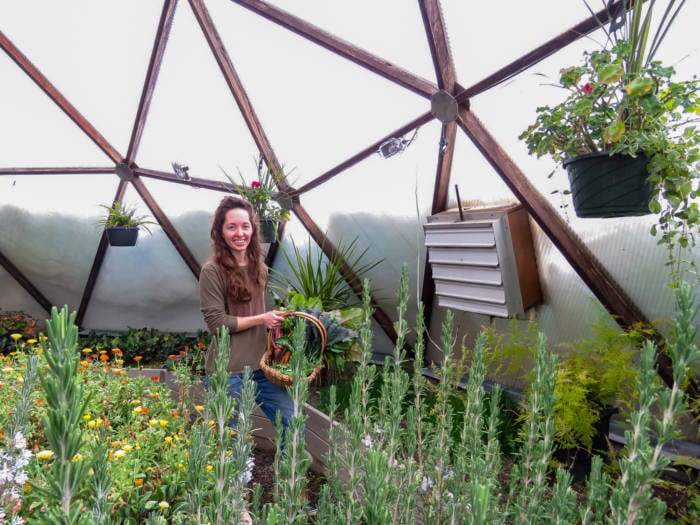
Vents and Fans:
Soil tends to dry out quickly in front of vents and fans. Many warm weather crops depend on large quantities of water to fruit. Optimal soil moisture levels and daily soil checks are essential for successful growth.
Perimeter Beds and Plants:
The soil in the perimeter beds, especially on the south side of the dome, tends to get hot and dry out quickly. It is suggested that plants are given sufficient space from polycarbonate panels. To help control pests and diseases, be aware of any plant leaves that contact the polycarbonate or wood struts. Moisture accumulates and heat is trapped at the point of contact, which eventually rots the plant(s) or breeds fungal infections. This can become a problem for years to come if allowed to prevail in your dome. Give plants space they will need when they are grown to maturity so that you do not have to cut them away from the polycarbonate and struts.
Plants That Produce Best When Matured Outside:
There is a small group of plants that produce best outside. They sometimes benefit from being started in the dome, then moved out. The polycarbonate has a UV coating to extend the life of the material and make maintenance easier. There are a few summer crops that benefit from more UV light like Squash, Cucumbers, Melons, and Beans. Though they will grow in the dome, they will not produce as much fruit and will tend to be leggy or get fungal infections. We recommend moving them to the outer south side of your dome where they will benefit not only from UV, but also from the heat and light reflecting off of the polycarbonate during the day. Also, the dome itself is a source of thermal mass, which is beneficial to these plants outside your dome. This way your garden will thrive both inside and outside the dome. Raised beds built around the foundation wall on the outside of the dome also create additional insulation for your perimeter beds inside the dome during the winter.
Shade Cloth:
The shade cloth is a valuable tool when you don’t have natural shade in your dome from large central, vines or towering plants, so hang the Shade Cloth that comes with your kit. The shade cloth is also useful for new domes when there are little to no mature plants growing yet. Summer shade will be helpful if you want to grow loads of leafy greens like lettuces, kale, and other cool crops as listed for North and East Zones.
Shade cloth is best not used when growing plants in the South and West Zones as they benefit from heat and light. In this case, it is best to rely on ventilation and fans to not only stabilize temperatures but also give these more sensitive plants the many benefits of air movement.
Greenhouse Planting Schedule:
Please also refer to our detailed Greenhouse Planting Schedule for more information on the greenhouse growing seasons and what to plant in early spring and fall!
We are here to help with all your backyard greenhouse gardening questions and any comments about our greenhouse planting guide. Please don’t hesitate to watch our videos, read our articles, and reach out to us. Your success is our greatest joy!
Are you or other Growing Dome greenhouse growers interested in being featured in our monthly newsletter “The Happy Grower” and on our social media platforms (Facebook and Instagram)? Apply here. Have questions about greenhouse gardening? Send an email to: info@growingspaces.com
